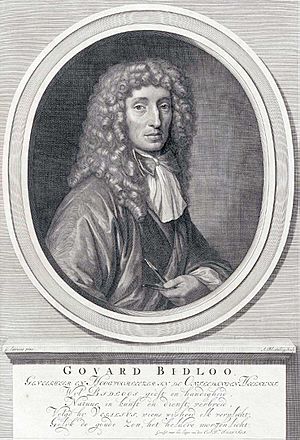Govert Bidloo facts for kids
Govert Bidloo (born March 12, 1649 – died March 30, 1713) was a very talented Dutch person from the Dutch Golden Age. He was a doctor, an expert in human anatomy, a poet, and a writer of plays. He even became the personal doctor for William III, who was the Dutch leader (called a stadholder) and also the King of England, Scotland, and Ireland.
Bidloo was also well-known for his writing. He wrote many poems, and he wrote the words (called a libretto) for the first-ever Dutch opera, Bacchus, Ceres en Venus (1686). His writings were collected and published in three books after he passed away.
One of Bidloo's students was his nephew, Nicolaas Bidloo. Nicolaas later became the personal doctor for the Russian ruler Peter the Great. He also started a medical school in Moscow.
Contents
Life and Career of Govert Bidloo
Govert Bidloo was born in Amsterdam into a family called Mennonites. His father was a hatter, and his older brother, Lambert Bidloo, was a literary apothecary. Lambert made sure Govert learned Latin very well, as well as Dutch.
Govert started learning surgery, and in 1670, he became a student of the famous anatomist Frederik Ruysch. He then studied medicine at the University of Franeker, earning his degree in 1682.
In 1688, he started teaching anatomical dissection in The Hague. By 1690, he was put in charge of the national hospital service. He also held this important job in England starting in 1692. In 1694, he became a professor of anatomy and medicine at Leiden University. He taught there until he died in 1713.
Anatomia Hvmani Corporis and Fingerprints
In 1685, Govert Bidloo published a very important book about human anatomy. It was called Anatomia Hvmani Corporis, which means Anatomy of the Human Body. This book was special because it described the unique patterns on our skin, like fingerprints. This was one of the first scientific observations that helped create the idea of using fingerprints to identify people.
The book had 105 detailed pictures drawn by Gerard de Lairesse. These pictures showed the human body both as living people and as dissected bodies. Later, an English surgeon named William Cowper copied parts of this book for his own work, Anatomy of the Humane Bodies (1698). Cowper did not give credit to Bidloo or de Lairesse, which caused a big disagreement between them.
Discovering the Liver Fluke Life Cycle
Bidloo also helped discover how the liver fluke (a type of worm called Fasciola hepatica) lives and grows. He noticed that worms with the same body structure were found in the bile ducts of different animals, like sheep, calves, deer, and even humans. He also saw eggs inside these worms, which were later identified as F. hepatica eggs. This helped scientists understand the full life cycle of this parasite.
Royal Physician to William III
In 1695, William III, who was the Dutch stadholder and also the King of England, asked Bidloo to become his personal doctor. This was a very important role. King William III passed away in Bidloo's arms on March 8, 1702.
In 1696, Bidloo was chosen to be a Fellow of the Royal Society of London. This is a very respected group of scientists. He died in Leiden when he was 64 years old.
Images for kids
Sources
- University of Glasgow
- Biographisch anthologisch en critisch woordenboek der Nederduitsche dichters (Dutch)
- Stichting Medisch en Farmaceutisch Museum De Griffioen (Dutch)




